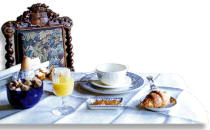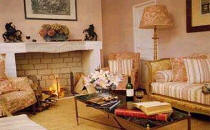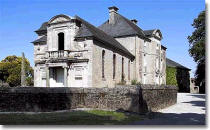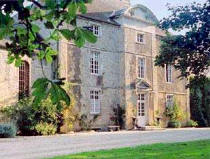![]()
![]()
![]()
![]()
![]()
![]()
![]()
![]()
![]()
![]()
![]()
![]()
![]()
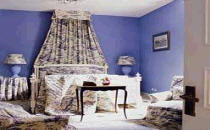
The manoir is
at once imposing and intimate; a fine example of perfectly proportioned,
seventeenth century architecture. It was completed in 1675, by the Marechal de
Bellefonds, first marshal of France and a close companion of King Louis XIV, The
Sun King. Originally built as a retirement home for wounded soldiers who had
served under the marechal during his various campaigns, later the manor became a
summer retreat. The house is flanked by a fine stable block and an exquisite and
historically important, Italianate chapel designed by Mansard, architect to the
court of Versailles, which suffered extensive damage during the D-Day invasion
and is now undergoing careful renovation. The broad entrance hall is graced by a
perfect, original, stone floor and runs right through the centre of the
building. It is furnished with fine antique chairs and armoires, all of local
origin, and leads to the Manoir's secluded, walled garden a la Vauban - like a
little fortress, protected from the world: a magical spot.
Each of the apartments has its own, private, outdoor space. The garden is
lovingly maintained and lends itself perfectly to picnics, croquet, al fresco
dining or quiet solitude. The Manoir has been extensively renovated in recent
years and is now divided into three luxurious, self-contained apartments: The
Chevalier, The Marquise and The Marechal. Each apartment is exquisitely
furnished and equipped with every contemporary convenience. They feature both
family antiques and ultra-modern plumbing and heating, with a choice of bath and
shower facilities - truly the best of both worlds. Fresh bed linen and bath
towels are supplied on request.
The Manor recently featured in English Country Homes & Interiors and in American
Victoria Magazine.
The Apartments
Each apartment is exquisitely furnished and equipped with every convenience
La Marquise: Named after the Marquise d'Aigneaux, an ancestor, the apartment is
a romantic retreat on the ground floor. The bedroom/drawing room with it's
fireplace is painted cornflower blue with matching Toile de Jouy - the printed
fabric depicting landscapes and figures for which the eighteenth-century factory
of Jouy-en-Josas, near Versailles, was famous. The spacious dining room/kitchen
area features the imposing, original stone fireplace. There is a large all white
bathroom with bath, shower, large basin and WC. A private terrace off the
kitchen looks out over the large garden.
Le Chevalier: Named after the Chevalier Sainte Marie du Mont, the ancestor who
founded a nearby town, this suite of two large rooms is on the ground floor and
is decorated in spring colours. The main salon is resplendent in Empire yellow.
The modern, galley kitchen gives access to the gardens & private terrace. The
bedroom is painted in celadon green. The bathroom is accessible from the bedroom
& the salon, making it possible for 2 people to sleep in the salon on
comfortable single beds.
Le Marechal: Named after the Marechal de Bellefonds, the illustrious ancestor,
this large apartment occupies the entire first floor - the piano nobile of
Renaissance architecture. It commands extensive and delightful views of the
verdant, Norman countryside. The large dining/drawing room is painted in antique
rose and can comfortably accommodate ten at the table. Across the hall is: A
chic, country kitchen. The third bathroom. The two master bedrooms both have en
suite bathrooms and are decorated with antiques and Toile de Jouy fabrics.
Between them is: A twin bedded room. The Marechal has its own, private, stone
staircase and large private terrace with a outdoor dining table in the garden.
Activities & Attractions
Parc Naturel Régional des Marais du Cotentin et du Bessin: The manoir is located
at the heart of this nature reserve. A rich variety of flora and fauna can be
observed in the protected 70,000-acre park. There are seals in the Baie des Veys
near Carentan and Isigny, and thousands of birds: teal, waders, oyster-catchers,
curlew, buzzards, tern, storks, and migratory birds of all kinds.
D-Day Landing Beaches
Le Mont Saint-Michel: The most visited monument in France and eighth wonder of
the world.
Villedieu-les-Poęles: The town is full of workshops where coppersmiths create
the world famous pots and pans. One can also visit one of the oldest bell
foundries in France. Great for gift shopping.
Bayeux: The 70 metres long Bayeux tapestry, embroidered in wool with 58 scenes,
traces the great adventure of the Norman conquest of England.
Caen: Many restored medieval churches, including the Abbaye aux Hommes with the
tomb of William the Conqueror and the Abbaye aux Dames, with that of his queen
Mathilde. There are fine art museums & galleries and the Memorial dedicated to
Peace, which offers an unforgettable experience.
La Hague: This is the North-western corner of the Cotentin, a granite outcrop
very similar to Brittany or Cornwall, with tiny winding roads and houses huddled
into valleys out of the wind. The painter Millet came from Gréville, and the
poet Jacques Prévert spent his last years in a house behind Port-Racine, the
smallest port in France. Prévert's garden is open to visitors.
Cherbourg: This town used to be the port of departure for transatlantic liners
(including the Titanic), and its deep-water berth still frequently hosts cruise
ships. The port is the world's biggest artificial harbour, and was a major
objective for the allied forces after D-day. The town of Cherbourg is charming;
not too large, with pedestrian streets, picturesque quay sides and good
shopping, and a spectacular view from the Fort du Roule on its cliff above the
town.
Travel
Airports: Caen - 95 km. Cherbourg - 50 km. Paris - 300 km
Road: Channel ports: Cherbourg, Caen, Le Havre
Rail: Carentan - 10 km (Paris Gare St-Lazare)
